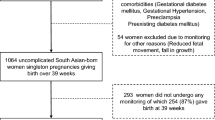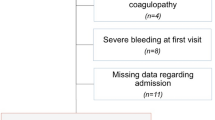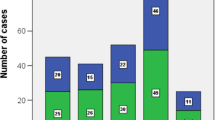Abstract
Objective:
To determine if apparently healthy post-term South Asian-born (SA) women were more likely to have abnormal post-term fetal surveillance than Australian- and New Zealand-born (AUS/NZ) women, whether those abnormalities were associated with increased rates of obstetric intervention and adverse perinatal outcomes, and whether SA women and their babies were at higher risk of adverse outcomes in the post-term period irrespective of their post-term surveillance outcomes.
Study Design:
Post-term surveillance and perinatal outcomes of 145 SA and 272 AUS/NZ nulliparous women with a singleton post-term pregnancy were compared in a retrospective multicentre cohort analysis.
Results:
Post-term SA women were not significantly more likely to have a low amniotic fluid index (AFI) than AUS/NZ women. However, they were nearly four times more likely (odds ratio 3.75; 95% CI 1.49–9.44) to have an abnormal CTG (P=0.005). Irrespective of maternal region of birth having an abnormal cardiotocography (CTG) or AFI was not associated with adverse intrapartum or perinatal outcomes. However, post-term SA women were significantly more likely than AUS/NZ women to have intrapartum fetal compromise (P=0.03) and an intrapartum cesarean section (P=0.002). Babies of SA women were more also significantly likely to be admitted to the Special Care Nursery or Neonatal Intensive Care Unit (P=0.02).
Conclusion:
Post-term SA women experience higher rates of fetal compromise (antenatal and intrapartum) and obstetric intervention than AUS/NZ women. Irrespective of maternal region of birth an abnormal CTG or AFI was not predictive of adverse outcomes.
This is a preview of subscription content, access via your institution
Access options
Subscribe to this journal
Receive 12 print issues and online access
$259.00 per year
only $21.58 per issue
Buy this article
- Purchase on Springer Link
- Instant access to full article PDF
Prices may be subject to local taxes which are calculated during checkout
Similar content being viewed by others
References
Drysdale H, Ranasinha S, Kendall A, Knight M, Wallace EM . Ethnicity and the risk of late-pregnancy stillbirth. Med J Aust 2012; 197 (5): 278–281.
Waterstone M, Bewley S, Wolfe C . Incidents and predictors of severe obstetric morbidity: case-control study. Brit Med J 2001; 322: 1089–1094.
Dahlen HG, Schmied V, Dennis CL, Thornton C . Rates of obstetric intervention during birth and selected maternal and perinatal outcomes for low risk women born in Australia compared to those born overseas. BMC Pregnancy Childbirth 2013; 13: 1–9.
Balchin I, Whittaker JC, Patel RR, Lamont RF, Steer PJ . Racial variation in the association between gestational age and perinatal mortality: prospective study. Brit Med J 2007; 334 (7598): 833.
Patel RR, Steer P, Doyle P, Little MP, Elliott P . Does gestation vary by ethnic group? A London-based study of over 122,000 pregnancies with spontaneous onset of labour. Int J Epidemiol 2004; 33 (1): 107–113.
Balchin I, Whittaker JC, Lamont RF, Steer PJ . Maternal and fetal characteristics associated with meconium-stained amniotic fluid. Am J Obstet Gynecol 2011; 117 (4): 828–835.
McFadyen IR, Campbell-Brown M, Abraham R, North WR, Haines AP . Factors affecting birthweights in Hindus, Moslems and Europeans. Br J Obstet Gynaecol 1984; 91 (10): 968–972.
Gülmezoglu AM, Crowther CA, Middleton P, Heatley E . Induction of labour for improving birth outcomes for women at or beyond term. Cochrane Database Syst Rev 2012; 6: CD004945.
Feldman GB . Prospective risk of stillbirth. Obstet Gynecol 1992; 79 (4): 547–553.
Olesen AW, Westergaard JG, Olsen J . Perinatal and maternal complications related to postterm delivery: a national register-based study, 1978-1993. Am J Obstet Gynecol 2003; 189 (1): 222–227.
Minakami H, Kimura H, Honma Y, Tamada T, Sato I . When is the optimal time for delivery? – purely from the fetuses’ perspective. Gynecol Obstet Invest 1995; 40 (3): 174–178.
Ingemarsson I, Kallen K . Stillbirths and rate of neonatal deaths in 76,761 postterm pregnancies in Sweden, 1982-1991: a register study. Acta Obstet Gynecol Scand 1997; 76 (7): 658–662.
Hilder L, Costeloe K, Thilaganathan B . Prolonged pregnancy: evaluating gestation-specific risks of fetal and infant mortality. Br J Obstet Gynaecol 1998; 105 (2): 169–173.
Sanchez-Ramos L, Olivier F, Delke I, Kaunitz AM . Labor induction versus expectant management for postterm pregnancies: a systematic review with meta-analysis. Obstet Gynecol 2003; 101 (6): 1312–1318.
National Institute for Health and Clinical Excellence. Induction of Labour: NICE Clinical Guideline 70. London: United Kingdom; 2008 [updated July 2008; accessed on 10 July 2016]. Available at https://www.nice.org.uk/guidance/cg70/chapter/1-guidance#induction-of-labour-in-specific-circumstances.
Clinical Practice Obstetrics Committee; Maternal Fetal Medicine Committee Clinical Practice Obstetrics Committee; Maternal Fetal Medicine Committee, Delaney M, Clinical Practice Obstetrics Committee; Maternal Fetal Medicine Committee, Roggensack A, Clinical Practice Obstetrics Committee; Maternal Fetal Medicine Committee, Leduc DC, Clinical Practice Obstetrics Committee; Maternal Fetal Medicine Committee, Ballermann C, Clinical Practice Obstetrics Committee; Maternal Fetal Medicine Committee, Biringer A et al. Guidelines for the management of pregnancy at 41+0 to 42+0 weeks. J Obstet Gynaecol Can 2008; 30 (9): 800–823.
United Nations Statistics Division. Composition of macro geographical (continental) regions, geographical sub-regions, and selected economic and other groupings [Internet]. New York: United Nations; 2013 [updated 2013 Oct 31; cited 2016 Feb 28]. Available at http://unstats.un.org/unsd/methods/m49/m49regin.htm.
The Royal Australian and New Zealand College of Obstetricians and Gynaecologists Intrapartum Fetal Surveillance Clinical Guideline, 3rd edn. Ranzcog: Victoria, Australia, 2014; 68p.
Rutherford SE, Phelan JP, Smith CV, Jacobs N . The four-quadrant assessment of amniotic fluid volume: an adjunct to antepartum fetal heart rate testing. Obstet Gynecol 1987; 70: 353–356.
Phelan JP, Park YW, Ahn MO, Rutherford SE . Polyhydramnios and perinatal outcome. J Perinatol 1990; 10 (4): 347–350.
National Statement on Ethical Conduct in Human Research 2007 (updated May 2015). The National Health and Medical Research Council, the Australian Research Council and the Australian Vice-Chancellors’ Committee. Commonwealth of Australia, Canberra.
Caughey AB, Snegovskikh VV, Norwitz ER . Postterm pregnancy: how can we improve outcomes? Obstet Gynecol Surv 2008; 63 (11): 715–724.
Rand L, Robinson JN, Economy KE, Norwitz ER . Post-term induction of labor revisited. Obstet Gynecol 2000; 96: 779–783.
Alexander JM, McIntire DD, Leveno KJ . Forty weeks and beyond: pregnancy outcomes by week of gestation. Obstet Gynecol 2000; 96 (2): 291–294.
Treger M, Hallak M, Silberstein T, Friger M, Katz M, Mazor M . Post-term pregnancy: should induction of labor be considered before 42 weeks? J Matern Fetal Neonatal Med 2002; 11 (1): 50–53.
Gibson-Helm M, Boyle J, Block A, Teede H . Use of country of birth as an indicator of refugee background in health datasets. BMC Med Res Methodol 2014; 14: 27.
Author information
Authors and Affiliations
Corresponding author
Ethics declarations
Competing interests
The authors declare no conflict of interest.
Rights and permissions
About this article
Cite this article
Yim, C., Wong, L., Cabalag, C. et al. Post-term surveillance and birth outcomes in South Asian-born compared with Australian-born women. J Perinatol 37, 139–143 (2017). https://doi.org/10.1038/jp.2016.190
Received:
Revised:
Accepted:
Published:
Issue Date:
DOI: https://doi.org/10.1038/jp.2016.190



